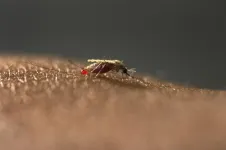INFORMATION:
Detecting ADHD with near perfect accuracy
Machine learning model is superior to similar predecessors or traditional behavioral diagnosis, says UB researcher
2021-01-27
(Press-News.org) BUFFALO, N.Y. - A new study led by a University at Buffalo researcher has identified how specific communication among different brain regions, known as brain connectivity, can serve as a biomarker for attention deficit hyperactivity disorder (ADHD).
The research relied on a deep architecture using machine-learning classifiers to identify with 99% accuracy those adults who had received a childhood diagnosis of ADHD many years earlier.
"This suggests that brain connectivity is a stable biomarker for ADHD, at least into childhood, even when an individual's behavior had become more typical, perhaps by adapting different strategies that obscure the underlying disorder," said Chris McNorgan, an assistant professor of psychology in the UB College of Arts and Sciences, and the study's lead author.
The findings, published in the journal Frontiers in Physiology, have implications for not only detecting ADHD, a common but diagnostically slippery disorder that's difficult to identify, but can also help clinicians target treatments by understanding where patients sit on a broad-spanning continuum.
"Because certain pharmaceuticals react with certain pathways, understanding the different types of ADHD can help inform decisions about one medication versus others," said McNorgan, an expert in neuroimaging and computational modeling.
Attention deficit disorder is the most commonly diagnosed psychological disorder among school-aged children, but it's hard to identify. Furthermore, multiple subtypes complicate a clinical definition of ADHD.
A clinical diagnosis of ADHD in a patient can change when that same patient returns for a subsequent evaluation.
"A patient may be exhibiting behavioral symptoms consistent with ADHD one day, but even days later, might not present those symptoms, or to the same degree," said McNorgan. "It could just be the difference between a good day and a bad day.
"But the brain connectivity signature of ADHD appears to be more stable. We don't see the diagnostic flip-flop."
The multidisciplinary research team of UB undergraduate research volunteers Cary Judson from the Department of Psychology and Dakota Handzlik in the Department of Computer Science and Engineering, and John G. Holden, an associate professor of psychology at the University of Cincinnati, used archival fMRI data from 80 adult participants who were diagnosed with ADHD as children.
Machine learning classifiers where then applied to four snapshots of activity during a task designed to test the subject's ability to inhibit an automatic response.
Focused analysis of individual runs achieved 91% percent diagnostic accuracy, while the collective analysis came close to 99%.
"It's by far the highest accuracy rate I've seen reported anywhere - it is leagues beyond anything that has come before it, and well beyond anything that has been achieved with a behavioral assessment," said McNorgan. "Many factors likely contributed towards our superior classification performance."
Previous research suggesting a relationship between brain connectivity and ADHD used direct linear classification. This research looks at relationships between something and what that something is predicting, such as coffee and performance.
For many ranges, direct linear classification is effective, but the relationship between coffee and performance, like behavioral symptoms and ADHD, is not linear. One or two cups of coffee might increase performance, but at some point, the caffeine might hurt performance. Nonlinear relationships exist when you can have "too little or too much of a good thing," according to McNorgan.
Deep learning networks are well-suited for detecting conditional relationships, which are nonlinear. In the case of the current study, ADHD was predicted from the patterns of communication between groups of brain areas, say, A, B and C. If regions A and B were highly connected, that could be predictive of ADHD, but not if these regions were also highly connected to region C. These sorts of relationships are problematic for the most commonly-used techniques, but not for deep-learning classifiers.
McNorgan's model goes further by also differentiating individuals with ADHD that have typical or atypical performance on the Iowa Gambling Task (IGT). The IGT is a behavioral paradigm similar to a casino card game that presents both high- and low-risk options, and is commonly used to study and diagnose ADHD.
Traditional techniques can't make more than one classification at a time. McNorgan's approach elegantly ties ADHD diagnosis to performance on the IGT to provide a potential bridge that explains why both are related to the brain's wiring.
Also, even though people with ADHD tend to make riskier choices in the IGT, it's not a universal determinant. Some people without ADHD also make riskier choices than others.
"This approach by differentiating both of these dimensions provides a mechanism for sub-classifying people with ADHD in ways that can allow for targeted treatments," said McNorgan. "We can see where people are on the continuum."
Because different brain networks are implicated in people at either ends of the continuum, this method opens the door for developing therapies that focus on specific brain networks, he added.
ELSE PRESS RELEASES FROM THIS DATE:
Study: Sudden police layoffs in one US city associated with increases in crime
2021-01-27
Amid a sharp economic downturn in 2008, police departments around the United States experienced budget shortfalls that required them to enact cutbacks. A new study examined the effects on crime of budget shortfalls in two New Jersey cities--one of which laid off more than 10 percent of its police force while the other averted layoffs. The study found that the police layoffs were associated with significant increases in overall crime, violent crime, and property crime.
The study, by researchers at John Jay College of Criminal Justice and Rutgers University, appears in Justice Evaluation Journal, a publication of the Academy of Criminal Justice Sciences.
"Our study suggests that sudden and drastic reductions in the size of a police force via layoffs of police officers ...
Mammogram-based breast cancer risk model could lead to better screening guidelines
2021-01-27
A new machine learning algorithm based on mammograms can estimate the risk of breast cancer in women more accurately than current risk models, according to a study from Adam Yala and colleagues. The algorithm, which was tested with datasets from three large hospitals located worldwide, could help clinicians design guidelines for breast cancer screening that meet the need for early detection while reducing false-positives, test costs, and other issues associated with overscreening. Mammograms are the most common method to screen for breast cancer, as more than 39 million procedures are performed in the U.S. annually. However, their widespread adoption has not gone without ...
'Smart' cartilage cells programmed to release drugs when stressed
2021-01-27
Working to develop new treatments for osteoarthritis, researchers at Washington University School of Medicine in St. Louis have genetically engineered cartilage to deliver an anti-inflammatory drug in response to activity similar to the bending of a knee or other motions that put stress on joints.
Among the early symptoms of osteoarthritis is pain in response to such movements -- motions that involve the so-called mechanical loading of a joint. Joint pain that accompanies bending or lifting can make it difficult to perform normal activities. But by altering genes in cartilage cells in the laboratory, the researchers have been able to program them to respond to the mechanical stress associated with movement and weight-bearing ...
In tune with the moon
2021-01-27
The blog "Ladyplanet. Natürlich Frau sein" is quite certain: "Our cycle is linked to that of the moon. The most obvious connection is the length of the two cycles," it says. The newspaper "Berliner Tagesspiegel" comes to the opposite conclusion: "The length of women's menstrual cycles is an average value, for some it lasts longer, for others it is shorter. Even one and the same woman can have cycles of different lengths. If they really were connected to the lunar cycle, all women would have their fertile days at the same time," the paper's knowledge section reads.
So what is true? A team led by Würzburg chronobiologist Charlotte Förster has now used scientific methods to examine the connection between ...
Cell death shines a light on the origins of complex life
2021-01-27
Organelles continue to thrive after the cells within which they exist die, a team of University of Bristol scientists have found, overturning previous assumptions that organelles decay too quickly to be fossilised.
As described in the journal Sciences Advances today [27 January], researchers from Bristol's School of Earth Sciences were able to document the decay process of eukaryotic algal cells, showing that nuclei, chloroplasts and pyrenoids (organelles found within chloroplasts) can persist for weeks and months after cell death in eukaryote cells, long enough to be preserved as fossils.
Emily Carlisle, a PhD student from Bristol's School of Earth Sciences and co-author, was able to characterise the transformation of the organelles into ...
Women's menstrual cycles temporarily synchronize with Moon cycles
2021-01-27
An analysis of long-term menstrual cycle records kept by 22 women for up to 32 years shows that women with cycles lasting longer than 27 days intermittently synchronized with cycles that affect the intensity of moonlight and the moon's gravitational pull. This synchrony was lost as women aged and when they were exposed to artificial light at night. The researchers hypothesized that human reproductive behavior may have been synchronous with the moon during ancient times, but that this changed as modern lifestyles emerged and humans increasingly gained exposure to artificial light ...
New malaria mosquito is emerging in African cities
2021-01-27
Larvae of a new malaria mosquito species are abundantly present in water containers in cities in Ethiopia. The mosquito, Anopheles stephensi, is the main malaria mosquito in India but only appeared on the African continent a few years ago. It has now been found in cities and towns in urban settings in Ethiopia, Sudan, and Djibouti. Researchers from the Radboud university medical center and the Armauer Hansen Research Institute in Ethiopia showed that the invading mosquito species is highly susceptible to local malaria strains. Malaria can therefore become an increasing problem for urban areas in ...
Growth of northern Tibet proved the key to East Asian biodiversity
2021-01-27
Pioneering work led by a joint China-UK consortium has revealed the origin of one of the world's most important ecosystems, the East Asian biodiversity "hotspot," thus solving a longstanding riddle as to what prompted its formation and evolution.
In a recent study published in Science Advances, a joint research team led by scientists from Xishuangbanna Tropical Botanical Garden (XTBG) of the Chinese Academy of Sciences, the University of Bristol (UK) and the Open University (UK) has revealed the first direct mechanism explaining how the growth of mountains in Northern Tibet drastically altered climate, vegetation and plant diversity in East Asia.
The researchers used an innovative climate model that simulates ...
Germline whole exome sequencing reveals the potential role of hereditary predisposition and therapeutic implications in small cell lung cancer, a tobacco-related cancer
2021-01-27
(Embargoed for January 28, 2021 3 a.m. SPT; January 27th 2 pm EST, 2021) -- Note: this study is scheduled for publication in the Journal Science Translational Medicine)
A study presented today by Dr. Nobuyuki Takahashi of the Center for Cancer Research (CCR), National Cancer Institute (NCI), Bethesda, Md. at the IASLC World Conference on Lung Cancer Singapore demonstrates that small cell lung cancer (SCLC) may have an inherited predisposition and lays the foundation for understanding the interaction between genotype and tobacco exposure in exacerbating SCLC risk as well as potential therapeutic implications. Because tobacco is the dominant carcinogen, secondary causes of lung cancer are often diminished in perceived importance, especially in SCLC, the most lethal ...
Pioneering research unravels hidden origins of Eastern Asia's 'land of milk and honey'
2021-01-27
A study has revealed for the first time the ancient origins of one of the world's most important ecosystems by unlocking the mechanism which determined the evolution of its mountains and how they shaped the weather there as well as its flora and fauna.
It was previously thought Southern Tibet and the Himalaya were instrumental in turning the once barren land of eastern Asia into lush forests and abundant coastal regions which became home to a rich array of plant, animal and marine life, including some of the world's rarest species. But new findings, published today in the journal Science Advances, conversely show Northern Tibet played the more influential role in this transformation which began more than 50 million years ago.
Scientists from a UK-China partnership, ...
LAST 30 PRESS RELEASES:
Numbers in our sights affect how we perceive space
SIMJ announces global collaborative book project in commemoration of its 75th anniversary
Air pollution exposure and birth weight
Obstructive sleep apnea risk and mental health conditions among older adults
How talking slows eye movements behind the wheel
The Ceramic Society of Japan’s Oxoate Ceramics Research Association launches new international book project
Heart-brain connection: international study reveals the role of the vagus nerve in keeping the heart young
Researchers identify Rb1 as a predictive biomarker for a new therapeutic strategy in some breast cancers
Survey reveals ethical gaps slowing AI adoption in pediatric surgery
Stimulant ADHD medications work differently than thought
AI overestimates how smart people are, according to HSE economists
HSE researchers create genome-wide map of quadruplexes
Scientists boost cell "powerhouses" to burn more calories
Automatic label checking: The missing step in making reliable medical AI
Low daily alcohol intake linked to 50% heightened mouth cancer risk in India
American Meteorological Society announces Rick Spinrad as 2026 President-Elect
Biomass-based carbon capture spotlighted in newly released global climate webinar recording
Illuminating invisible nano pollutants: advanced bioimaging tracks the full journey of emerging nanoscale contaminants in living systems
How does age affect recovery from spinal cord injury?
Novel AI tool offers prognosis for patients with head and neck cancer
Fathers’ microplastic exposure tied to their children’s metabolic problems
Research validates laboratory model for studying high-grade serous ovarian cancer
SIR 2026 delivers transformative breakthroughs in minimally invasive medicine to improve patient care
Stem Cell Reports most downloaded papers of 2025 highlight the breadth and impact of stem cell research
Oxford-led study estimates NHS spends around 3% of its primary and secondary care budget on the health impacts of heat and cold in England
A researcher’s long quest leads to a smart composite breakthrough
Urban wild bees act as “microbial sensors” of city health.
New study finds where you live affects recovery after a hip fracture
Forecasting the impact of fully automated vehicle adoption on US road traffic injuries
Alcohol-related hospitalizations from 2016 to 2022
[Press-News.org] Detecting ADHD with near perfect accuracyMachine learning model is superior to similar predecessors or traditional behavioral diagnosis, says UB researcher


